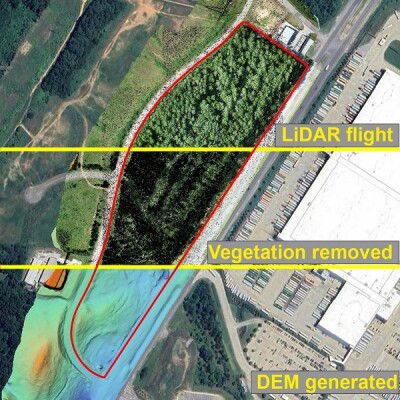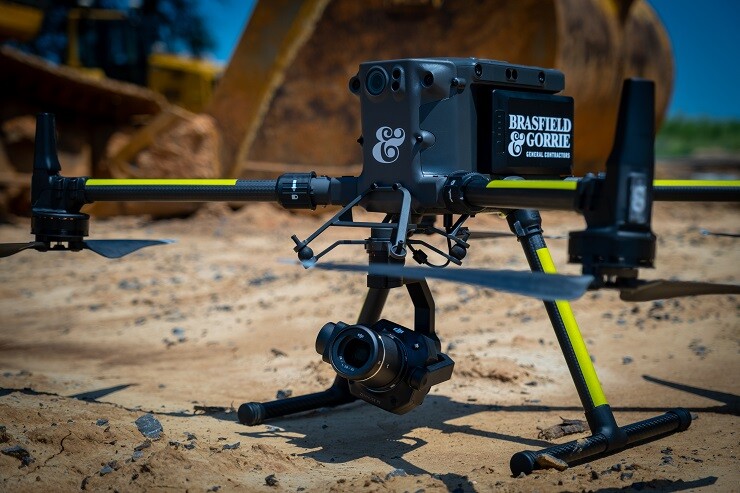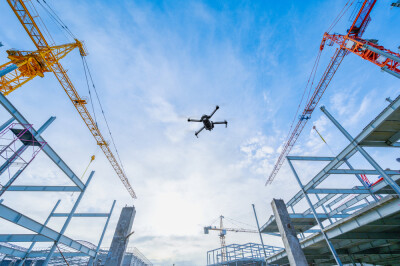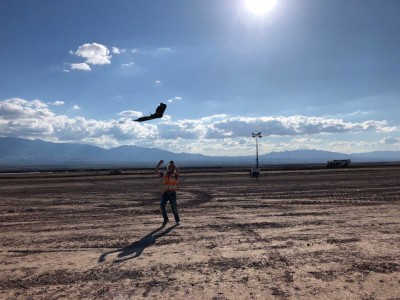One of the leaders in the use of drones in construction is Birmingham, Alabama-based contractor Brasfield & Gorrie. According to Ryan Hittie, Senior Innovation & Operational Tech Specialist, his company serves 15 different market sectors and flies drones regularly for operations in all of those fields.
“We have seen the most success on greenfield projects, where we track site conditions from before groundbreaking to final turnover, and brownfield projects, where we verify that sites meet conditions stipulated in our contracts,” he explained. “By the end of 2024, we expect drones to have been operating on 25% of our active projects.”
Brasfield & Gorrie have been using drones since 2017, when they began deploying the technology for mapping and for taking photos to mark the progress of construction projects. .png.small.400x400.png) Starting with just six drones, Brasfield & Gorrie grew its fleet to 38 drones by 2023. Today, more than 60 of the firm’s employees are FAA-certified UAV pilots.
Starting with just six drones, Brasfield & Gorrie grew its fleet to 38 drones by 2023. Today, more than 60 of the firm’s employees are FAA-certified UAV pilots.
Hittie said that his company’s continued and expanded adoption of uncrewed technology has been driven by the improved efficiency offered by drone-based operations. “Technology has advanced quickly over the last six years,” he stated. “What was once a multi-day, highly technical training process is now a day-long training that enables absolute beginners to collect high-quality, actionable data.”
Still, Hittie reported that his company has had some difficulty in accurately quantifying the value of drone-derived intelligence. “Most of the time, we can't quantify this value,” he stated. “We have, on multiple occasions, caught overages in material or identified test piles in locations that would eventually impact our underground work. When issues get caught early, it is hard to determine the impact it MIGHT have had on schedule, budget or continued safe operation of our site. But we know there is a positive impact. Quite often one drone flight helps make decisions that save more money than the cost of the drone for the entire year.”
Similarly, Hittie said that safety increases resulting from the use of uncrewed systems can be hard to quantify. “From a safety perspective, we've seen that tracking underground utility work or concrete formwork prevents utility strikes and reduces the need for silica remediation efforts when removing incorrectly poured slabs,” said Hittie. “There is a dollar value associated with safety, but we prioritize preventing harm to our workers over the bottom line cost to the job.”
Overall, the ability to access vast amounts of quality, usable data has strengthened Brasfield & Gorrie’s commitment to drones. That commitment is reflected in a recent company initiative. To guard against utility strikes, the company has been updating its site maps, using Esri’s Site Scan for ArcGIS Pro to incorporate drone flight data into their GIS maps. This integration of drone flight data directly into GIS maps has the potential to address problems associated with siloed data.
In addition, Brasfield & Gorrie has been generating 3D messages from its own imager processing tools to improve the way they track projects. According to Hittie, “Owners can only glean so much from an updated 2D aerial map, and there was no equivalent to a boots-on-the-ground view. We were, and still are, able to capture our sites in 3D that provide owners with a near real time presence on their sites. We have had success integrating our drone models into other technologies that have (at least in the opinion of the drone program team) been instrumental in winning new projects.”
These projects, along with Brasfield & Gorrie’s other uncrewed systems initiatives, highlight the ways the company has been able to unlock new efficiencies. “In the past, our project teams had access to one project at a time,” explained Hittie.  “I’ve been told by some project managers they have up to 15 web browser bookmarks for each project they work on. That is a tremendous number of data sources for one team to interact with and maintain. Integrating our data sources into one portal helps ease the strain of data management and offers insight into the work. And, viewing all project data from one dashboard offers regional intelligence, not merely hyper-local datasets.”
“I’ve been told by some project managers they have up to 15 web browser bookmarks for each project they work on. That is a tremendous number of data sources for one team to interact with and maintain. Integrating our data sources into one portal helps ease the strain of data management and offers insight into the work. And, viewing all project data from one dashboard offers regional intelligence, not merely hyper-local datasets.”
Despite the many advantages of using drones, there are many hurdles to jump as Brasfield & Gorrie seeks to expand and enhance its program. Not surprisingly, regulations remain a major challenge. Hittie told Commercial UAV News that “the regulatory landscape has proven to be the most difficult aspect of our drone program.”
“With 50+ active pilots at any time, we have to ensure that we quickly understand how policy change affects our operations and disseminate that information in an easy-to-understand format,” he explained. “In addition, hardware regulations also have a tremendous impact on our operations. Our Federal Division requires different drone hardware and software, so we have to carve out separate rates and provide more training to those pilots to ensure they are in compliance with federal regulations.”
Still, the challenges of working as a large-scale drone operator are outweighed by the improvements in safety, accuracy, and efficiency, and Hittie sees more improvements on the horizon. “I am legitimately looking forward to the robots ‘taking’ elements of my job,” he asserted. “Some flights we have executed required a pilot and observer and six hours of flight time. If both of us could be free to work elsewhere while the drone collected data for us, I would be thrilled.”
Moreover, Hittie said, “We'd love to use people for analysis and other tasks that we're uniquely suited for and leave the repetitive tasks to automation. We are also looking to continue the development of our connected job site technologies initiative. We map sites using drones, then send data to intelligent heavy machines that can dig autonomously. Having all the tools on our sites ‘talking’ and sharing data will make us better builders and provide better service for our clients.”
Speaking of those clients, Hittie foresees increased adoption of drone technology at Brasfield & Gorrie because more and more customers are asking for it. “We have heard some owners state they will no longer look at project proposals that do not include drone deliverables,” he said. “That's quite a change from early days when drones were sometimes viewed more as toys than as an essential tool.”
















Comments